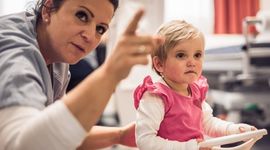Accidents
When life saving measures need to be taken there will be no time for thoughts about how fragile the skin is. You have to respond rapidly and in this case any damage to the skin you unfortunately have to accept.
A serious problem can often occur when the patient has to been placed on a respirator. When a patient with a severe form of EB is intubated (= placement of a plastic tube into the windpipe) problems can develop. The reason that problems can develop is the high risk of injury to the mucous membrane, and the small circumference in the area of the mouth and the trachea. When family members are at the scene of the accident they should inform the paramedic and emergency personnel about this problem. If there is no one at the scene of the accident that knows the person, the emergency medical personnel will quickly realize this and approach the situation carefully. Using the smallest possible Endotracheal tube available, that is well lubricated with gel, and the smallest laryngoscope (= a special device with a light on it to see into the throat and to place the Endotracheal tube) will help.
When the accident is not life threatening, it is advised to quickly inform the emergency personnel of the vulnerability of the patients skin and mucous membranes. You can then proceed with caution in taking care of the injury and the person affected.
Most important:
- Keep calm!
- Get help! When possible, inform the person that has come to help about the vulnerability of the persons skin.
- Life saving procedures! Always take priority over the protection of the vulnerable skin.
- An intubation (= placement of plastic tube for artificial respiration) for patients with severe forms of EB can de difficult. You should use a lot of gel on the smallest possible laryngoscope. Make sure the endo-tracheal tube is fixed in place with „tracheal tapes“made from gauze bandages. Avoid sticky surgical tapes whenever possible.
- Caution: When positioning the effected person you should always avoid a rubbing motion that causes friction to the surface of the skin! It is equally important to avoid these movements during positioning on tables for x-rays, CT scans and operating tables.
- Band-Aids and other sticky materials (i.e. ECG electrodes) should not be used! When removing the band aids or other glued materials the vulnerable skin often sticks. The fixation can be carried out with adherent, but non-adhesive material (i.e. Mepitac®, Mepilex®). In an emergency situation you will / can make an exception. It is essential to peel the used plaster (band aid) etc. very gently using the help of a "medical adhesive remover" (e.g. Niltac ®) or leave it alone and contact an EB specialist.
- The same is true for peripheral venous catheters (I.V.), which can be necessary for infusions. The fixation can also be carried out with adherent, but non-adhesive material (e.g. Mepitac ®, Mepilex ®). If you can only fixate one bandage, upon removal - of all other types of sticky type dressing bandages - proceed as described above.
- Blood draws and injections are possible. When preparing the skin for the procedure, please clean the area with disinfectant spray or gentle application avoiding friction or rubbing of the skin. After removal of the needle do not use a band aid rather use a fixating light pressure bandage.
- When applying a tourniquet or blood pressure cuff to the patients arm be careful not to injure the skin.
- The dressing technique for all wounds is the same - whether they are from an operation, an accident or just from EB itself.
- Dressing technique (initial and continuing care of open skin areas)
1. Gentle (!) cleaning and flushing (e.g. from contaminated wounds from an accident)
2. Direct contact wound dressing: no adhesive gauze (with or without Vaseline). When it is available you can also use Mepilex ® , a nice soft foam dressing suitable for EB skin.
3. Padding: with soft nonwoven gauze sponges
4. Fixation: with soft gauze or possibly tubular bandage - For the care of normal wounds for those affected with "regular" EB please follow these standardized methods!
- An open crush wounds can be sewn or glued, whichever is best suited for the current situation for the EB patient.
- When surgery is necessary it is important to have a patient on a soft operating table and careful positioning is needed to avoid pressure points. Surgical wounds usually heal well; you should try to set the suture a bit deeper in the subcutaneous layers as skin surface sutures do not hold well.
- Plaster casting with a fracture is possible; however it should have good padding underneath to prevent pressure sores. The skin underneath the plaster out to the edge must be protected with non-adhesive wound gauze.
- It is recommended that you should contact the EB center where the patient is known, as soon as it is possible.

